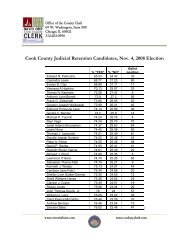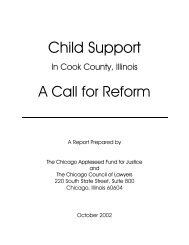Videoconferencing in Removal Hearings: A Case Study of the ...
Videoconferencing in Removal Hearings: A Case Study of the ...
Videoconferencing in Removal Hearings: A Case Study of the ...
You also want an ePaper? Increase the reach of your titles
YUMPU automatically turns print PDFs into web optimized ePapers that Google loves.
listens to <strong>the</strong> judge and non-English speak<strong>in</strong>g litigant on separate l<strong>in</strong>es through a headset,<br />
and <strong>in</strong>terprets what is said on one l<strong>in</strong>e <strong>in</strong>to <strong>the</strong> o<strong>the</strong>r l<strong>in</strong>e, where it is heard through a<br />
speakerphone by <strong>the</strong> judge or a headset by <strong>the</strong> litigant. In contrast to <strong>the</strong> traditional,<br />
“consecutive” telephonic <strong>in</strong>terpretation used by <strong>the</strong> Chicago immigration court, <strong>the</strong> Las<br />
Cruces system allows for simultaneous <strong>in</strong>terpretation.<br />
5. Enabl<strong>in</strong>g immigrants and <strong>the</strong>ir representative to confer<br />
With its capacity to impede deta<strong>in</strong>ed immigrants from effectively present<strong>in</strong>g <strong>the</strong>ir<br />
case, videoconferenc<strong>in</strong>g makes <strong>the</strong> need for counsel acute. Deta<strong>in</strong>ed immigrants who are<br />
held <strong>in</strong> remote facilities already are severely restricted from communicat<strong>in</strong>g with <strong>the</strong>ir<br />
attorneys. <strong>Videoconferenc<strong>in</strong>g</strong> creates a Hobson’s choice for immigrants’ attorneys: <strong>the</strong>y<br />
can ei<strong>the</strong>r appear at <strong>the</strong> remote site, where <strong>the</strong>y will be able to confer more freely with<br />
<strong>the</strong>ir clients but have reduced access to <strong>the</strong> court; or <strong>the</strong>y can appear <strong>in</strong> court, where <strong>the</strong>y<br />
will have greater access to <strong>the</strong> judge, trial attorney, and <strong>the</strong> file, but less access to <strong>the</strong>ir<br />
client. Mak<strong>in</strong>g it easier for attorneys to confer with <strong>the</strong>ir client from court will help to<br />
mitigate this problem.<br />
Recommendation: The court should establish private booths at court and at<br />
remote sites so that attorneys can have confidential discussions with <strong>the</strong>ir clients before,<br />
dur<strong>in</strong>g, or after hear<strong>in</strong>gs. 75 EOIR should make clear that judges must permit a recess <strong>of</strong> a<br />
hear<strong>in</strong>g, when requested, to give attorneys and <strong>the</strong>ir clients <strong>the</strong> opportunity to confer <strong>in</strong><br />
private.<br />
75 The Georgia Supreme Court, for example, mandates that <strong>in</strong> crim<strong>in</strong>al proceed<strong>in</strong>gs where<br />
videoconferenc<strong>in</strong>g is used, <strong>the</strong> defendant and defense counsel shall be provided with a private means <strong>of</strong><br />
communication. Ga. S. Ct. R. 9.2(b) (2005).<br />
56




